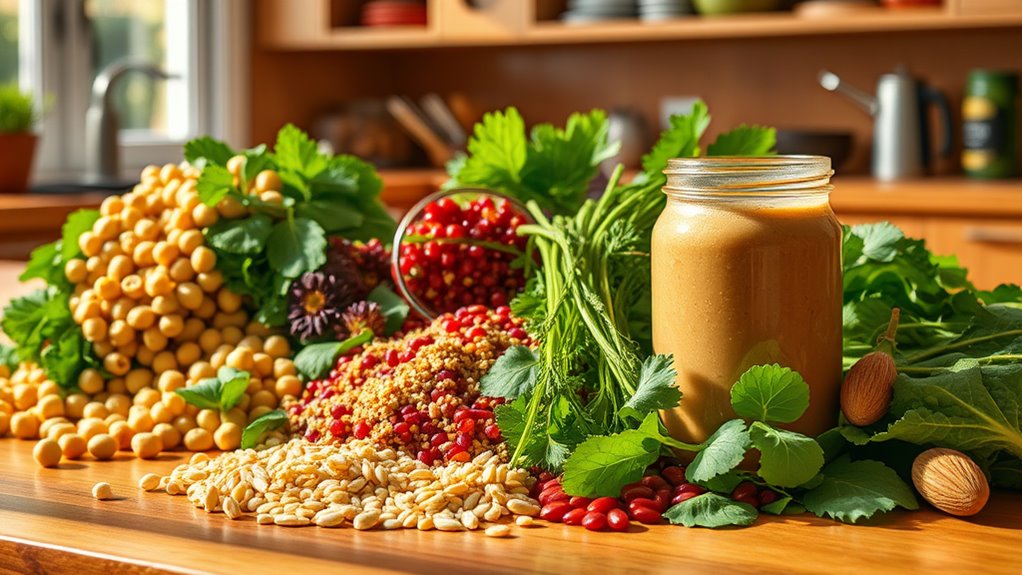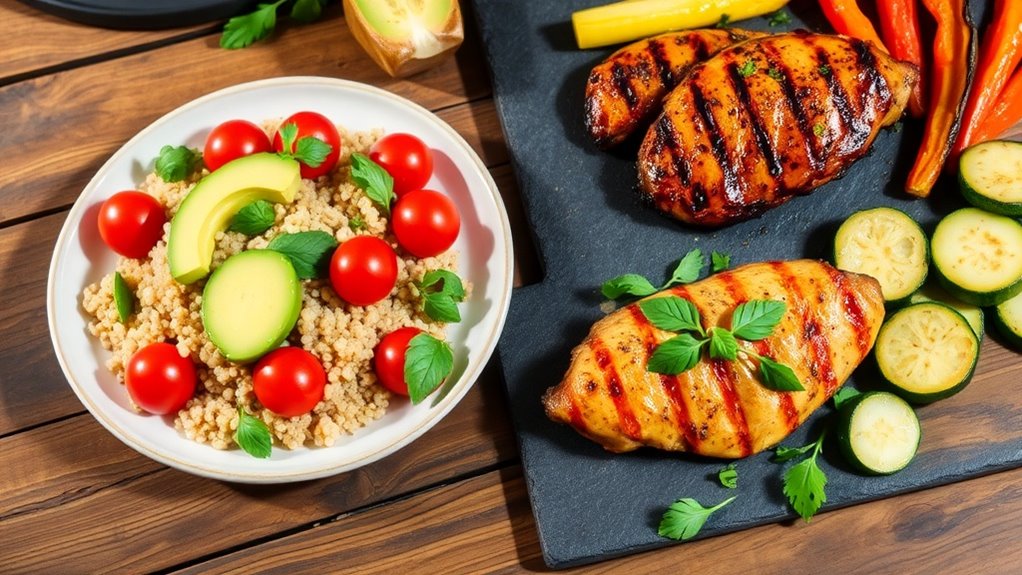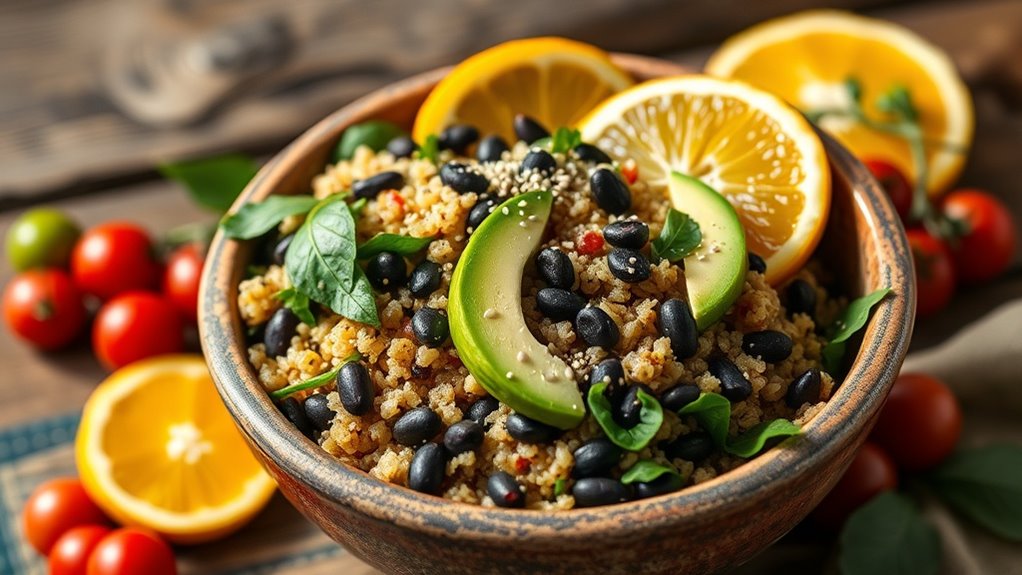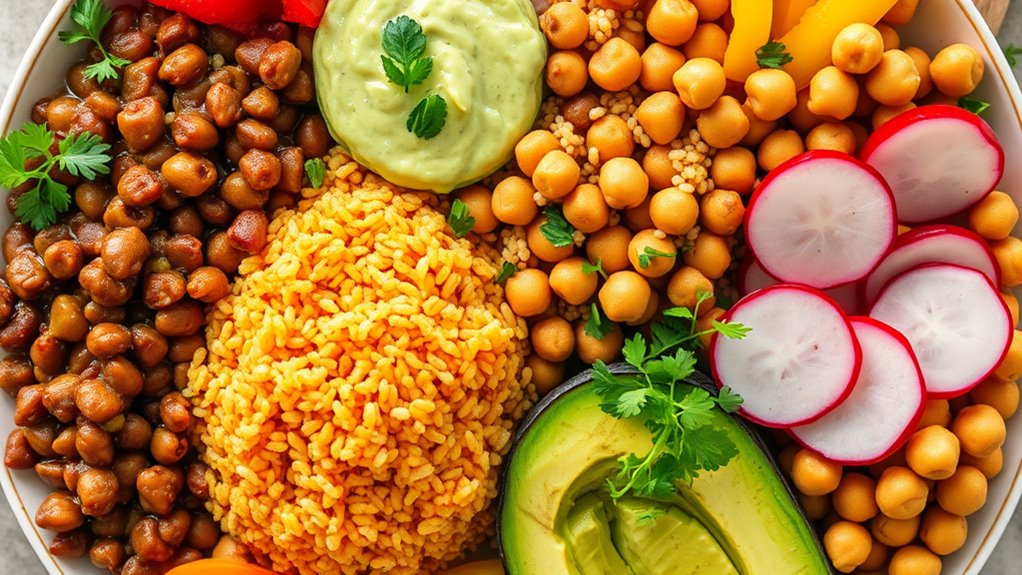Discover Plant-Based Proteins That Pack a Punch!
Discovering plant-based proteins that pack a punch is easier than you think! Legumes, like edamame and lentils, are high in protein and fiber, supporting heart health and digestion. Quinoa offers all essential amino acids, while nuts and seeds deliver healthy fats and nutrients. Tofu and tempeh provide versatile, protein-rich options, and seitan mimics meat’s texture. Don’t forget spirulina for a nutrient boost. There’s even more to explore about these powerhouses that can elevate your meals!
Key Takeaways
- Legumes and edamame are high in protein, fiber, and essential nutrients, supporting muscle repair and digestive health.
- Quinoa is a complete protein, containing all nine essential amino acids, plus fiber and iron for energy and vitality.
- Tofu and tempeh are versatile plant-based proteins, offering 8g and 19g of protein per 100g, respectively, with minimal calories.
- Nuts and seeds are rich in healthy fats, protein, and antioxidants, making them perfect for snacks or meal enhancements.
- Spirulina is a complete protein source, providing 4g of protein per tablespoon and packed with vitamins, minerals, and antioxidants.
The Power of Legumes
When you incorporate legumes into your diet, you tap into a powerhouse of nutrients that can enhance your overall health.
These plant-based marvels deliver a significant protein punch, often exceeding animal sources in fiber and essential nutrients. Beans, lentils, and chickpeas come packed with protein while providing a plethora of vitamins and minerals. They’re also low in fat, making them an ideal choice for health-conscious eaters.
As you explore different legumes, you’ll discover versatile cooking applications—from soups to salads to hearty stews. Embrace their adaptability in your meals, allowing yourself to elevate the protein content without sacrificing flavor. Moreover, legumes are known for their impressive health benefits, contributing to heart health and digestive wellness.
Quinoa: A Complete Protein
Although many grains fall short in providing all nine essential amino acids, quinoa stands out as a complete protein source. This means you can rely on quinoa not just for carbs, but for high-quality protein too. It’s particularly beneficial for those following a plant-based diet. Additionally, quinoa is a fantastic source of plant-based protein options, making it a versatile ingredient for various dishes.
Here’s a quick breakdown:
| Nutrient | Amount per 1 cup cooked |
|---|---|
| Protein | 8 grams |
| Fiber | 5 grams |
| Iron | 2.8 mg |
Incorporating quinoa into your meals is simple. Whether you’re creating a salad, bowl, or side dish, you’ll enhance both the nutritional profile and flavor. Embrace quinoa, and you’ll elevate your plant-based protein game!
Nuts and Seeds for Nutrition
Nuts and seeds pack a powerful nutritional punch, making them essential components of any plant-based diet. These tiny powerhouses are rich in protein, healthy fats, and essential nutrients.
Almonds, walnuts, and chia seeds aren’t just tasty; they’re loaded with antioxidants, vitamins, and minerals that support your overall health. Incorporating a variety of nuts and seeds into your meals can greatly enhance your nutrient intake.
They’re perfect as snacks, in smoothies, or sprinkled on salads to add texture and flavor. With their versatility and nutrient density, you can easily use them to push your meals to the next level. Additionally, many nuts and seeds offer superior meat alternatives that provide similar protein benefits while lowering environmental impact.
Tofu and Tempeh: Soy’s Superstars
After exploring the benefits of nuts and seeds, it’s time to spotlight another remarkable group in the plant-based protein world: tofu and tempeh. These soy-based superstars are not only packed with protein but also bring versatility to your meals. Tofu’s smooth texture adapts well to various dishes, while tempeh’s firm, nutty flavor elevates your culinary creations.
| Nutritional Component | Tofu (100g) | Tempeh (100g) |
|---|---|---|
| Protein | 8g | 19g |
| Fiber | 0.3g | 7.6g |
| Calcium | 150mg | 18mg |
Incorporate both in your diet to harness their unique attributes, and watch your plant-based protein intake soar!
Spirulina: The Algal Wonder
As you explore plant-based protein sources, don’t overlook spirulina, a vibrant blue-green algae that’s packed with nutrients.
This powerhouse offers about 4 grams of protein per tablespoon and contains all essential amino acids, making it a complete protein source.
Beyond protein, spirulina brings a host of vitamins, minerals, and antioxidants, supporting overall health. Its high concentration of phycocyanin lends it anti-inflammatory and antioxidant properties, which can enhance your wellness journey.
Spirulina is incredibly versatile—blend it into smoothies, sprinkle it on salads, or incorporate it into energy bars. It’s worth noting that spirulina is considered one of the unconventional protein sources that can significantly impact your nutrition.
As you dive deeper into plant-based nutrition, consider adding spirulina to your toolkit; it’s not just a supplement but a game-changer for your dietary approach.
Try it today for a nutritious boost!
Pea Protein: A Versatile Choice
Pea protein is an excellent choice if you’re looking for a nutritious plant-based option. With its impressive amino acid profile, it can easily boost your meals while keeping them delicious. Plus, you can explore various culinary uses and creative recipes that incorporate this versatile ingredient. Additionally, incorporating pea protein into your diet can provide unexpected health benefits that enhance overall well-being.
Nutritional Benefits of Pea
When exploring plant-based proteins, you’ll find that pea protein stands out due to its impressive nutritional profile. Packed with essential nutrients, it offers several advantages that can enhance your diet.
Here are three key benefits of incorporating pea protein into your meals:
-
High Protein Content: Pea protein contains about 25 grams of protein per 30 grams, making it a powerhouse for muscle building and repair.
-
Rich in Iron: It provides a significant source of iron, which is vital for energy production and transporting oxygen in your body.
-
Allergen-Friendly: Unlike many other protein sources, pea protein is hypoallergenic, making it suitable for individuals with dairy or soy sensitivities.
Embrace its benefits and boost your nutritional intake effectively!
Culinary Uses and Recipes
Incorporating pea protein into your meals opens up a world of culinary possibilities, thanks to its versatility and neutral flavor. You can seamlessly add it to smoothies, soups, or baked goods, enhancing nutrition without altering taste. Here’s a quick guide to some delectable uses:
| Dish Type | Pea Protein Use |
|---|---|
| Smoothies | Blend in for an extra protein boost |
| Soups | Stir in to thicken and enrich flavor |
| Baked Goods | Replace flour for added nutrition |
| Pasta Dishes | Use in sauces for a creamy texture |
| Energy Bars | Boost protein content easily |
Experiment with these ideas to elevate your culinary repertoire and create healthy, satisfying meals. Mastery comes with practice, so don’t hesitate to explore!
Whole Grains for Sustained Energy
Whole grains are your go-to for lasting energy throughout the day.
They pack a punch with essential nutrients that support your overall health.
Plus, with a few simple cooking tips, you can easily incorporate them into your meals.
Nutritional Benefits of Grains
As you explore plant-based proteins, you’ll discover that whole grains provide an excellent source of sustained energy.
These nutritional powerhouses offer a wealth of benefits that can fuel your body and keep you feeling full longer. Incorporating whole grains into your diet can help you achieve better health.
Here are three key benefits to contemplate:
-
Fiber-Rich: Whole grains contain ample fiber, aiding digestion and promoting gut health.
-
Nutrient-Dense: They’re packed with essential vitamins and minerals, like B vitamins and magnesium, supporting overall vigor.
-
Low Glycemic Index: Whole grains lead to gradual blood sugar spikes, delivering steady energy instead of crashes.
Cooking Tips for Grains
Cooking grains can be a game changer for your meals, especially when you want to harness their energy-boosting benefits.
Start by rinsing grains under cold water to remove excess starch, ensuring fluffiness. Use the right water-to-grain ratio; generally, it’s two cups of water for each cup of whole grains.
Bring water to a boil, then reduce to a simmer and cover, allowing them to cook undisturbed. Add flavor by incorporating herbs, spices, or broth instead of plain water.
For added texture, consider toasting grains in a dry pan before cooking. Finally, let them rest covered for about 10 minutes post-cooking to absorb moisture fully.
Master these techniques, and you’ll elevate your grain dishes into nutritious powerhouses!
Seitan: The Meat Alternative
If you’re seeking a hearty, plant-based protein that mimics the texture of meat, seitan might just be your new favorite ingredient.
This versatile protein, made from wheat gluten, can elevate your meals while offering numerous culinary possibilities.
Here’s how you can incorporate seitan into your dishes:
-
Stir-Fries: Slice seitan thinly and toss it with your favorite vegetables and sauces for a satisfying, savory stir-fry.
-
Sandwiches: Use seitan as a filling for sandwiches, pairing it with fresh greens and a tangy spread to rival any deli meat.
-
Curries: Add chunks of seitan to your curries, allowing it to soak up rich flavors and enhance the dish’s substance.
With seitan, mastering plant-based cooking becomes an exciting journey!
The Benefits of Edamame
Edamame, often enjoyed as a snack or appetizer, packs a powerful punch when it comes to health benefits. These young soybeans are rich in protein, delivering around 18 grams per cup, making them a fantastic source for vegans and vegetarians.
Containing essential amino acids, edamame supports muscle repair and growth. They’re also loaded with fiber, which aids digestion and contributes to weight management by promoting satiety.
Moreover, edamame boasts high levels of antioxidants such as isoflavones, which can lower the risk of chronic diseases. They’re a good source of vitamins C and K, along with folate and iron, crucial for overall health.
Frequently Asked Questions
Can I Get Enough Protein From a Plant-Based Diet?
Absolutely, you can thrive on a plant-based diet! Focus on diverse sources like legumes, nuts, seeds, and whole grains, ensuring you meet your protein needs. It’s easier than you might think to get sufficient protein!
Are Plant-Based Proteins Suitable for Athletes?
Yes, plant-based proteins can absolutely be suitable for athletes. You can build muscle and recover effectively by incorporating diverse sources like lentils, quinoa, and chickpeas into your diet, ensuring you meet your nutritional needs.
How Do I Combine Plant Proteins for Complete Amino Acids?
To combine plant proteins for complete amino acids, mix legumes, grains, and seeds. For instance, pair rice with beans or quinoa with chickpeas. These combinations guarantee you get all essential amino acids in your diet.
What Are the Best Sources of Plant-Based Calcium?
You’d think dairy’s the only calcium source, right? Surprise! Dark leafy greens, almonds, tahini, and fortified plant milks actually deliver great calcium. Mix these into your diet, and you’ll flex those bones like a pro!
Can I Find Plant-Based Protein Supplements?
Absolutely, you can find a variety of plant-based protein supplements. Look for options like pea protein, hemp protein, or brown rice protein. They’ll help you meet your nutritional goals without compromising on your dietary preferences.





